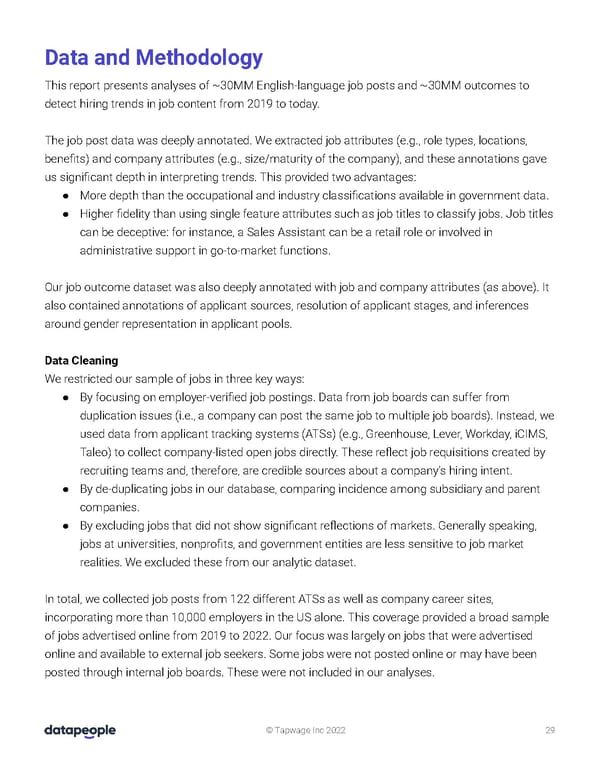Data and Methodology This report presents analyses of ~30MM English-language job posts and ~30MM outcomes to detect hiring trends in job content from 2019 to today. The job post data was deeply annotated. We extracted job attributes (e.g., role types, locations, benefits) and company attributes (e.g., size/maturity of the company), and these annotations gave us significant depth in interpreting trends. This provided two advantages: ● More depth than the occupational and industry classifications available in government data. ● Higher fidelity than using single feature attributes such as job titles to classify jobs. Job titles can be deceptive: for instance, a Sales Assistant can be a retail role or involved in administrative support in go-to-market functions. Our job outcome dataset was also deeply annotated with job and company attributes (as above). It also contained annotations of applicant sources, resolution of applicant stages, and inferences around gender representation in applicant pools. Data Cleaning We restricted our sample of jobs in three key ways: ● By focusing on employer-verified job postings. Data from job boards can suffer from duplication issues (i.e., a company can post the same job to multiple job boards). Instead, we used data from applicant tracking systems (ATSs) (e.g., Greenhouse, Lever, Workday, iCIMS, Taleo) to collect company-listed open jobs directly. These reflect job requisitions created by recruiting teams and, therefore, are credible sources about a company’s hiring intent. ● By de-duplicating jobs in our database, comparing incidence among subsidiary and parent companies. ● By excluding jobs that did not show significant reflections of markets. Generally speaking, jobs at universities, nonprofits, and government entities are less sensitive to job market realities. We excluded these from our analytic dataset. In total, we collected job posts from 122 different ATSs as well as company career sites, incorporating more than 10,000 employers in the US alone. This coverage provided a broad sample of jobs advertised online from 2019 to 2022. Our focus was largely on jobs that were advertised online and available to external job seekers. Some jobs were not posted online or may have been posted through internal job boards. These were not included in our analyses. © Tapwage Inc 2022 29
 Hiring in Distributed World Page 29 Page 31
Hiring in Distributed World Page 29 Page 31